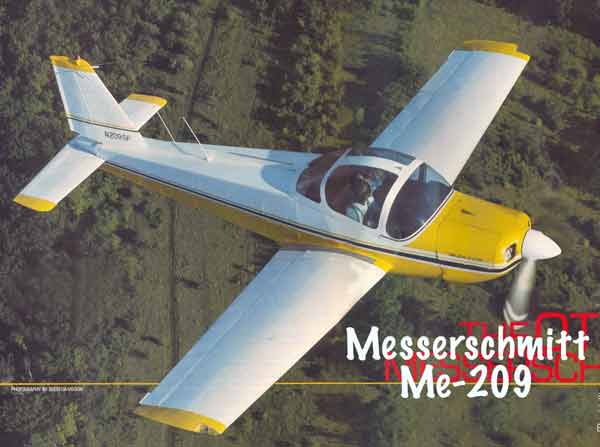
 |
MBB-209 Monsun:
Few and Far Between |
PAGE FOUR
On one approach, Art showed me how effective the flaps actually were by maintaining nearly 800 feet of altitude onto a very, very short final — so short in fact, I wasn't certain we could even dive and hit the numbers, much less land on them. At that point, Art ran the prop pitch full in and simply dropped the nose. The drag on the airplane was so fierce with full flaps that we picked up maybe 15 knots and then stabilized at that speed while we were coming down at a truly awesome angle. I monitored the airspeed while he flared at the bottom end and noticed it obediently came right back to proper approach speed while he was bringing the nose up to level for the runway. If those aren't enough ways to lose altitude, the 209 also slips like a fiend with the flaps out. This is one airplane for which there is no excuse in overshooting a runway. After a few go-rounds on our 2000 foot strip, we were about 3/4 of the way down the runway on the final one. I said "Okay Art, you better get on the brakes;' totally forgetting neither one of us had brakes. And he laughingly reminded me I had the brakes between the seats and I reached down to pull them up smoothly, slowing to a halt- before either one of us had to don our water wings. The MBB-209 (too much is being made of the Messerschmitt lineage) is, to put it bluntly, one hell of an airplane. The Monsun flies like a heavy airplane, has the sporting spirit of a small fighter and is a great 150 mph cross-country machine. Unfortunately with only ten in the country (and only eight of those are still flyable), that puts the airplane out of the reach of most of us. However, it's intriguing to consider what has happened to the other 90 air-craft which were produced and are still in Europe. Reportedly over 60 of the aircraft were being used as trainers for the Swedish Air Force. Whether these are 150 horse or 160 versions or possibly even the 115 horse model is unknown. What is equally unknown is whether the Swedes are still using them and how soon they will be disposed of the trainers. Is there a possible stockpile of these aircraft soon to be available to civilian pilots or have they already been surplussed and absorbed into the growing Europe-an sport aviation market? If they haven't been turned loose yet, who knows? Maybe the time will come when the American dollar is once again worth something and we can bring a few over here. Turnabout is fair play, considering the number of our air-planes going abroad. The airplane presents a tremendously wide fun utility ratio and its usability is expanded even further considering the wings are designed to be folded alongside the fuselage so the Monsun can be towed home behind a car with the nose gear retracted. Art states folding the wings is not simply a matter of pulling a pin here and there. He says it's a relatively major operation that makes doing it on a daily basis impractical. Will we see more 209's flitting around in American skies in the future? Maybe, but only if the American dollar turns around. Will we see the airplane produced? Probably not, unless some European consortium (or maybe even MBB itself) decides to get back into the little airplane business. If they do, they have a fine design and if the price could be kept within reasonable limits they would probably find a ready market worldwide. There is always Art Patstone's airplane. Will he sell it? Not only would he not sell it, he won't even discuss the matter. So don't bother calling. I already have. BD For
lots more pilot reports like this one go to PILOT
REPORTS
*) The performances are based on the equipment with retractable nose wheel. |
|||||||||||||||||||||||||||||||||||||||||||||||||||||||||||||||||||||||||||||||||||||||||||||||||||||||||||||||||||||||||||||||||||||||||||||||||||||||||||||||||||||||||||||||